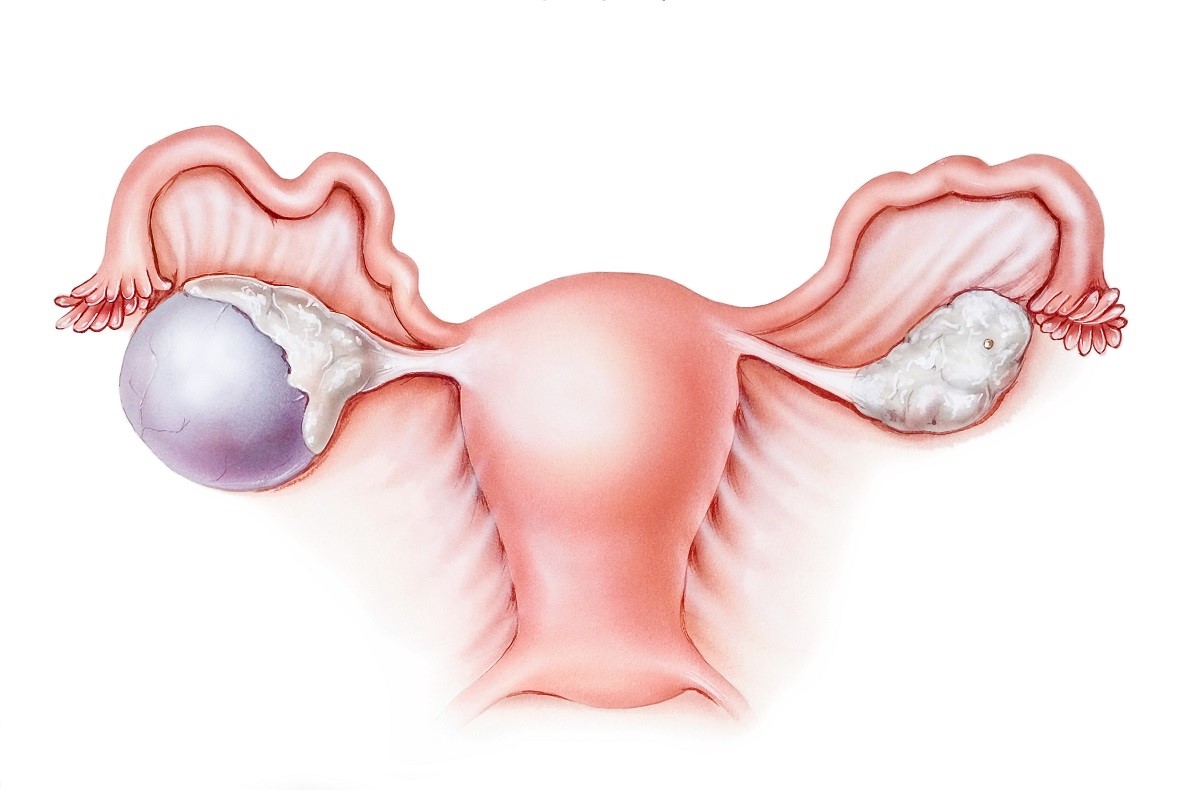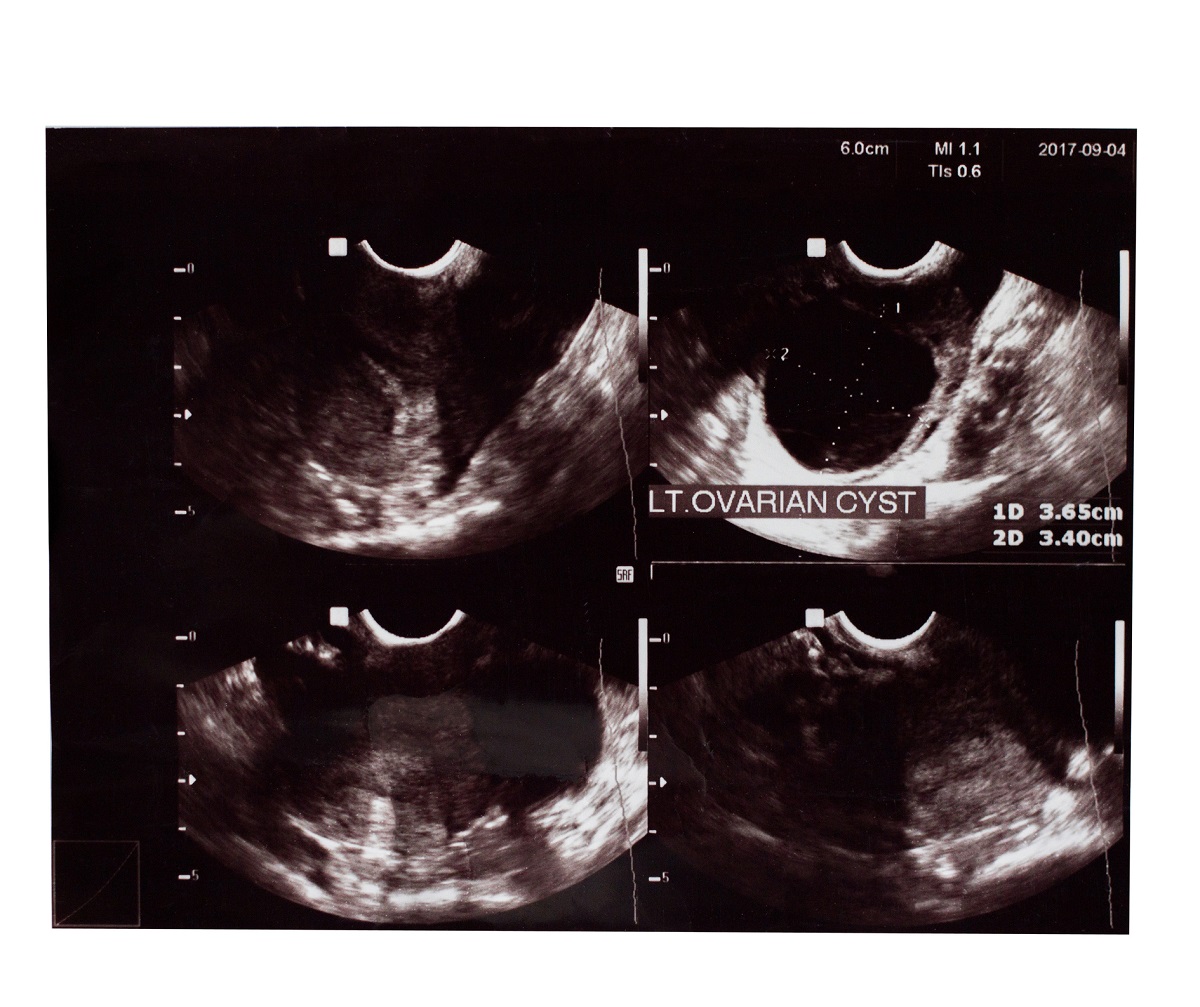- Overview of pathology: Jarmila Bártová
- mojgynekolog.sk - Cystic ovarian disease (ovarian cyst)
- medicinenet.com - Ovarian cysts: symptoms, causes, types and treatment.
- healthline.com - Ovarian cysts
- mayoclinic.org - Ovarian cysts
Cyst on the ovary: Why does it arise, what are its symptoms and diagnosis?

An ovarian cyst is a fluid-filled sac. It is surrounded by a thin layer of tissue. It occurs in the ovary or on its surface.
Most common symptoms
- Malaise
- Loss of pubic hair
- Thickening of the voice
- Vaginal Discharge
- Flank Pain
- Abdominal Pain
- Period pain
- Ovulation pain
- Painful bowel movements
- Lower Abdominal Pain
- Groin Pain
- Painful urination
- Back Pain
- Frequent urination
- Increased body temperature
- Nausea
- Rash
- Bleeding after sexual intercourse
- Oily skin
- Gaining weight
- Excessive Hair Loss: Causes, Treatment
- Overweight
- Indigestion
- The Island
- Menstrual cycle disorders
- Fatigue
- Vaginal discharge
- Vomiting
- Long menstrual bleeding
Characteristics
A cyst is an enclosed sac filled with fluid, blood or semi-solid matter. A cyst is a mass larger than 2 cm. When multiple cysts are present, each cyst may be of an individual size.
Many women develop an ovarian cyst during their lifetime.
Often cysts appear in women of reproductive age or in women in transition, i.e. at menopause.
There are different types of cysts. Some are harmless, others can cause more serious problems for a woman.
Most of the cysts that occur are not cancerous and do not cause ovarian cancer.
The most common are painless cysts. Such cysts do not present any complications or pain. They disappear on their own within a few months without treatment.
Cysts are also a common part of the menstrual process. They are, for example, follicular cysts, cysts of the corpus luteum. They appear mainly during ovulation and usually disappear after a few menstrual cycles.
These cysts are usually without visible symptoms. In many cases, a woman does not even notice them.
The rupture of an ovarian cyst can cause complications.
Cysts present on the ovaries are divided into
Benign, benign - this group includes ectopic pregnancies nested on the ovary
Malignant - form malignant tumors
Borderline tumors - form a separate chapter
Polycystic ovary syndrome
Secondary ovarian tumours - these are metastases from another cancer

Causes
For example, it can be a build-up of fluid that has formed during menstruation or the menstrual cycle. A cyst can arise as a result of overproduction of certain hormones or hormonal imbalances and before menopause.
If left untreated, certain types of cysts, such as polycystic ovary syndrome or endometriosis, can lead to infertility.
The risk of developing an ovarian cyst increases
- Hormonal imbalance
- Medications that promote ovulation
- Pregnancy, where a cyst formed during ovulation remains on the ovary until the end of pregnancy
- Endometriosis
- Pelvic infection that has also affected the ovaries can cause a cyst to form
- A previous cyst on the ovary. If a cyst has already formed once, there is a high probability that a new cyst will form
- Metabolic origin due to obesity, high blood pressure
Non-malignant ovarian cysts are classified based on the tissue they originate from.
Epithelial cysts arising from the epithelium of the ovary are divided into
A functional cyst also called a follicular cyst. It is often 3-8 cm in size, has clear contents and is often asymptomatic. It arises when the egg is not released from the follicle but continues to grow.
It can form at any time during the menstrual cycle when follicles, which are structurally similar to cysts, grow in the ovaries during the cycle. The follicles produce hormones and release the egg during ovulation.
This is the most common type of cyst. They are usually harmless. They also occur frequently in early pregnancy.
A corpus luteum cyst is formed when an egg is released from the follicle of the ovary. The follicle turns into what is called a corpus luteum. Fluid begins to accumulate in it, forming a cyst.
A corpus luteum cyst causes a delay in menstruation. On examination, a thick lining and vascular supply can be seen around the perimeter of the cyst.
In a hemorrhagic cyst, the corpus luteum bleeds. Numerous images of clotted blood are seen on ultrasound.
Endometrial cyst is an ovarian form of endometriosis. It is common in women of reproductive age. It affects approximately 12% of women.
On ultrasound, a thicker, regularly shaped and milky-looking cyst is visible in which small, lighter dots form. This cyst is hormonally active and may change according to the menstrual cycle.
An endometrial cyst causes pain in the pelvic area and leads to infertility.
In polycystic ovaries, numerous small cysts more than 3 cm in size are visible on one ovary. These cysts cause disturbances in the menstrual cycle and lead to impaired fertility.
Soft tissue tumors include fibroids and hemangiomas.
Dermoid cysts, also called teratomas or germ cell tumors, originate from the germ cells of the ovary. Therefore, these cysts can contain different types of tissues such as teeth, nails, hair and others.
On ultrasound, they are visible as smooth-walled. A round shape is seen inside their wall. They are dealt with by surgical removal.
Gonadostromal tumors are rare and are usually associated with pregnancy.
Cystadenomas are fluid-filled cysts. They form on the surface of the ovary.
Cystadenomas and dermoid cysts can cause coiling of the ovary as they grow. This causes pain and can obstruct blood flow through the ovary.
Not every cyst is dangerous.
Symptoms
Cysts occur throughout a woman's life and often go unnoticed.
Some cysts go on without any symptoms. A woman may not even know about them.
Sometimes a woman will experience pain and irregular bleeding outside of her menstrual cycle or menstruation may be delayed.
If the cyst grows to a larger size, it can cause pain in the pelvis on the side of the cyst.
With ovarian cysts, symptoms such as
- Bloating and indigestion
- Menstrual cycle disorders, delayed or early menstruation outside the cycle
- Breast tenderness
- Pain
- If the cyst grows to a larger size, it causes a feeling of fullness in the abdomen
- Pain in the sacrum
- Increase in abdominal circumference
- Painful bowel movements
- Feeling the urge to pass stool
- More frequent feeling of a full bladder
- Pain during intercourse
The cause of pain is often the rupture of the cyst and the release of its contents into the abdominal cavity. This can irritate the abdominal lining and cause pain in the lower abdomen.
During ovulation, the follicle ruptures and the subsequent release of the egg and fluid into the abdominal cavity. This can cause pain.
The pain may be caused by the growth of the cyst and pressure on surrounding organs such as the bladder, rectum, and subsequent bleeding into the cyst.
A burst cyst can cause severe, sharp pelvic pain to internal bleeding. This is a life-threatening condition. However, it depends on the size of the cyst, its blood supply and internal contents.

Diagnostics
Often, the cyst is detected during a preventive examination at the gynecologist, and the woman has no problems.
Larger cysts can also be detected by palpation, specifically palpation of the anterior abdominal wall or ovary.
Ultrasound is used to detect cysts using a vaginal probe.

When a cyst is detected, an examination is carried out
- Blood sampling, hormone levels are checked and blood is taken for oncomarkers
- Sonography, CT and MRI
Sonography is used to examine and obtain information regarding the cyst, specifically
- On which side the cyst is located
- What is the filling of the cyst - a black filling of the cyst on ultrasound indicates watery contents of the cyst
- Surrounding possible bleeding, dead tissue
- The shape of the cyst is observed and whether there are multiple foci
- The mobility of the cyst in relation to its surroundings
- Its borders, whether it is regularly circumscribed
- What is the thickness of the cyst lining
- Its vascular supply, how it is supplied and nourished by blood
- Whether there is free fluid around the ovary
Course
Cysts that form on the ovary after menopause pose a high risk of cancer. Every woman should therefore continue to have regular gynaecological examinations after menopause.
Smaller cysts (ovarian cysts of 2 to 6 cm in size), which have no symptoms or manifestations, are usually uneventful. Often, apart from minor changes in bleeding, a woman may not even know she has a cyst.
Larger and more serious ovarian cysts develop gradually. They may first show pain around the abdomen or lower abdomen and later changes in bleeding during menstruation.
Cancerous cysts have the most serious course. Cancerous cysts can metastasize to the surrounding area, for example to the uterus or abdominal cavity.
Complications associated with ovarian cyst formation
Torsion of the ovary, i.e. rotation of the ovary. As the cyst enlarges, it changes the position of the ovary and shifts it. It may twist as it grows. Not enough blood reaches the ovary until the blood supply stops completely.
A common symptom of ovarian coiling is the sudden onset of sharp pain in the pelvis on the side of the cyst, nausea or vomiting.
If the symptoms are sudden, intense and do not subside, it is a more problematic cyst (for example, a haemorrhagic - bloody cyst). It will also present with other symptoms, such as discharge.
If the cyst has a hormonal basis, thickening of the voice, hair growth is present. Other times, hair loss and balding are present.
Sometimes there is a cessation of ovulation or even the appearance of acne on the skin.
The formation of ovarian cysts cannot be prevented. Therefore, it is important for a woman to go for regular gynecological examinations.
The examination will reveal newly formed cysts as well as those that have not ruptured and persist. Unless a woman has complications, she never knows how long an ovarian cyst will persist. Therefore, the gynecologist monitors whether the cyst is growing or remains unchanged.
If you have symptoms that you attribute to an ovarian cyst, it is important to see a gynecologist. The gynecologist will confirm or refute your concerns.
This is because the symptoms of a cyst can mimic those of cancer.
Common symptoms occurring with ovarian cyst and ovarian cancer are:
- Changes in the menstrual cycle
- Persistent pain in the pelvic area
- Unappetite, weight loss
- Feeling of bloated abdomen
Rupture of an ovarian cyst
If the cyst is small, it may not cause problems. Its rupture will go unnoticed.
In some cases, the cyst suddenly bursts. It may cause severe pain on the side of the burst cyst that has suddenly formed.
The cyst may burst during physical exertion, exercise or after sexual intercourse.
A ruptured cyst will cause severe pain but will not cause fever or gastrointestinal problems.
Sudden and severe pain in the pelvis or abdomen requires an immediate visit to the doctor and hospital.
Pelvic pain with a feeling of vomiting and fever also requires an immediate visit to the doctor and treatment.
The effect of cysts on a planned pregnancy
Some types of cysts can cause fertility problems. Polycystic ovary syndrome and endometriosis also reduce the ability to conceive.
Cyst during pregnancy
During pregnancy, a cyst sometimes appears on the ovary that has been detected during a prenatal examination. During pregnancy, these are usually harmless, benign cysts that do not require surgery.
During pregnancy, cysts that have caused acute complications, such as interruption of the blood supply to the ovary or rupture and subsequent bleeding into the abdominal cavity, are surgically removed. Cysts suspected of being malignant, i.e. a tumour where the cyst poses a risk to the ongoing pregnancy, are also removed.
If a cyst is present in pregnancy, strenuous pregnancy exercises or physical activity should be avoided. During activity, the cyst may rupture, which can already endanger the ovaries and the fetus.
How it is treated: Cyst on the ovary
How to get rid of and treat cysts on the ovaries? By surgery or medication?
Show moreSymptoms of ovarian cysts - video
Gallery





Cyst on the ovary is treated by
Other names
Interesting resources










